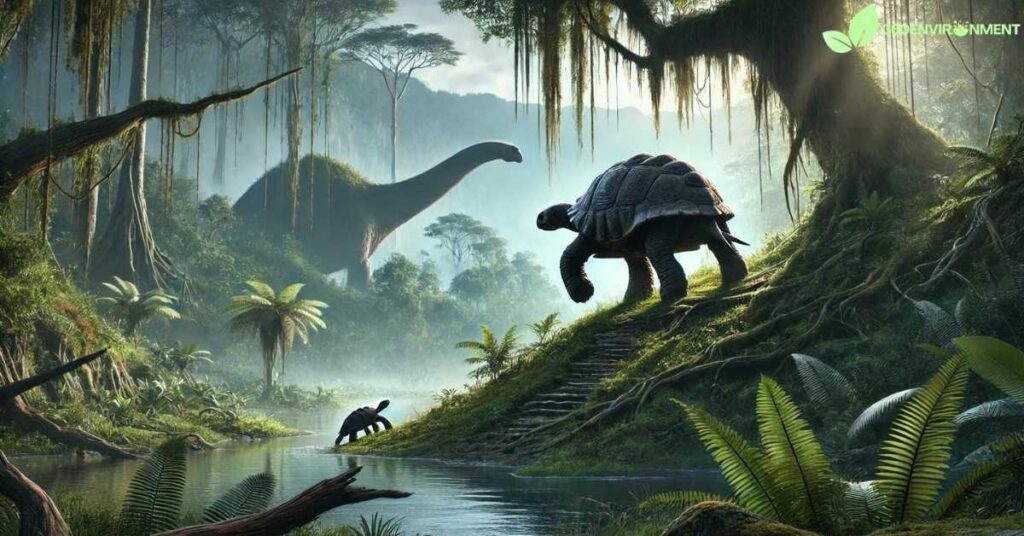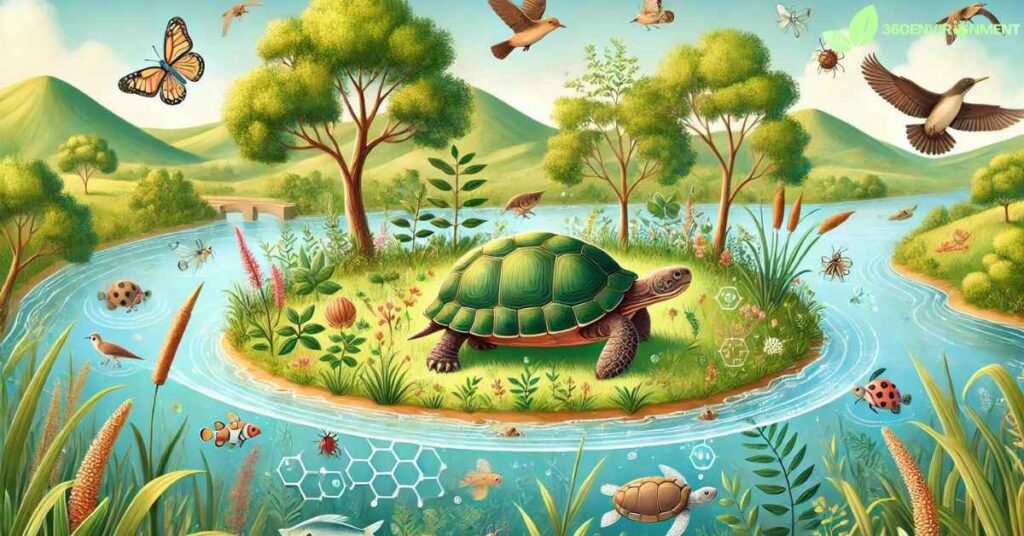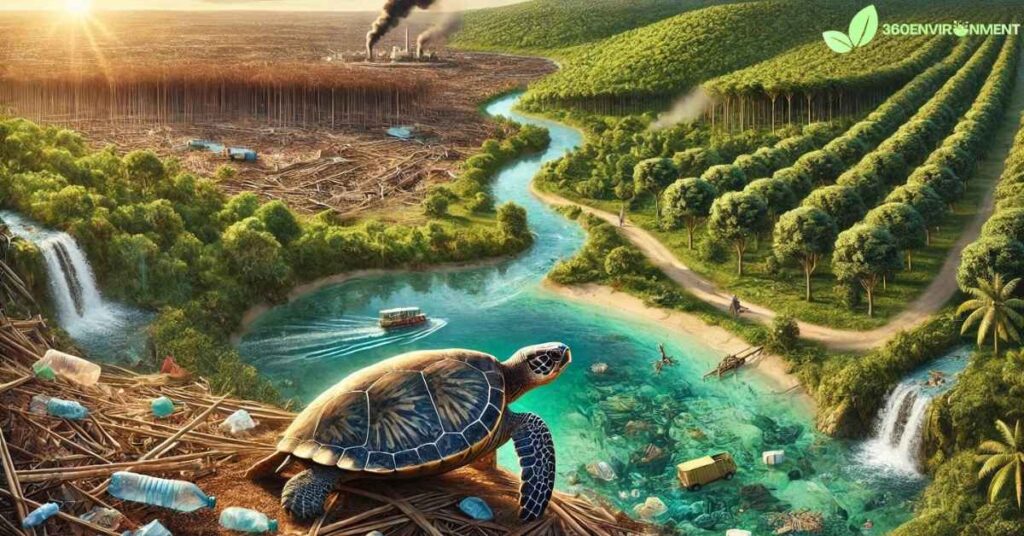Turtles have long fascinated humans, both as ancient creatures that have survived since the time of dinosaurs and as gentle animals that inhabit various ecosystems across the globe. However, one of the common questions that arise when discussing turtles is: Are turtles reptiles or amphibians? The answer to this question lies in understanding the biological classification of turtles, their evolutionary history, and the specific ecological roles they play in the environments they inhabit.
In this article, we will explore turtles and try to find out, Are turtles reptiles or amphibians, how they fit into their environmental niche, and the specific characteristics that define them. We will also delve into their ecological importance, how they interact with their environments, and the conservation challenges they face in today’s changing world.
1. Understanding the Classification of Turtles
The question of whether turtles are reptiles or amphibians is easily answered from a biological classification perspective. Turtles are reptiles, belonging to the class Reptilia. However, understanding what makes turtles reptiles rather than amphibians requires a deeper look into the traits and characteristics that distinguish these two groups of animals.

1.1. What Defines a Reptile?
Reptiles, including turtles, belong to the class Reptilia, which also includes other well-known animals like snakes, lizards, and crocodilians. Several key characteristics define reptiles:
- Cold-blooded (ectothermic): Reptiles regulate their body temperature using external heat sources, such as the sun. This makes them dependent on their environment for thermoregulation.
- Scales: One of the defining characteristics of reptiles is the presence of scales or scutes. Turtles, while not having the scales that snakes or lizards do, have scutes—thick, hardened plates made of keratin that cover their shells.
- Lungs for breathing: Unlike amphibians, which may breathe through their skin in addition to using lungs (especially during certain stages of their life cycle), reptiles rely exclusively on lungs for respiration throughout their entire lives.
- Amniotic eggs: Reptiles, including turtles, lay amniotic eggs. These eggs have a protective shell that prevents desiccation and allows them to be laid on land, unlike amphibians, which usually lay soft eggs in water.
- Dry, impermeable skin: Reptiles have skin that is relatively dry and waterproof, in contrast to the moist, permeable skin of amphibians, which is adapted to absorb moisture and oxygen from the environment.
1.2. Why Aren’t Turtles Amphibians?
In answering the question of “Are turtles reptiles or amphibians” let’s talk about why they are not Amphibians, such as frogs, toads, and salamanders, belong to the class Amphibia. While turtles and amphibians share certain traits, they are distinct in several important ways:
- Life cycle: Amphibians undergo metamorphosis. They typically start life as aquatic larvae with gills (such as tadpoles) and later develop lungs as they transition to adult forms capable of living on land. Turtles do not go through such a metamorphic stage. They hatch from eggs as miniature versions of their adult selves and are fully formed with lungs and other adult characteristics.
- Habitat dependence: While some turtles, like aquatic species, spend significant amounts of time in water, they are not tied to water in the same way amphibians are. Amphibians require water for reproduction and skin moisture, while turtles lay eggs on land and do not rely on water for breathing.
- Skin: Amphibians have permeable skin that can absorb water and oxygen, which is a critical feature for their respiration. Turtles, as reptiles, have dry, scaly skin that acts as a barrier against water loss, enabling them to live in dry habitats without needing to keep their skin moist.
2. Evolutionary History of Turtles
Turtles are one of the oldest reptilian groups, with fossil evidence suggesting they have existed for over 200 million years, predating many other reptiles. Their long evolutionary history provides insight into their adaptation to a variety of habitats and environments.

2.1. Early Turtle Fossils and Adaptations
The earliest turtle ancestors date back to the late Triassic period. These early turtles, like Proganochelys, had many of the characteristics we associate with modern turtles, including a hard shell and a body adapted for life both on land and in water. However, their skulls were more primitive, and their teeth were different from modern turtles, which lack teeth and have beak-like jaws instead.
- Shell evolution: One of the most distinctive features of turtles is their shell, which is composed of two parts: the upper carapace and the lower plastron. These structures are unique among vertebrates and provide turtles with significant protection from predators.
- Adapting to various environments: As turtles evolved, they adapted to a wide range of environments. Some turtles, like the giant Galápagos tortoises, evolved to live in dry, terrestrial environments, while others, like the sea turtles, evolved to thrive in marine ecosystems. This evolutionary adaptability allowed turtles to spread across the globe and inhabit various ecological niches.
2.2. Turtles as Survivors
The ability of turtles to thrive in diverse habitats has allowed them to survive mass extinctions and climate changes over millions of years. Their slow metabolism, longevity, and effective defense mechanisms (such as their hard shells) have contributed to their survival. However, the same traits that helped turtles thrive for so long also make them vulnerable to modern threats, such as habitat loss and climate change.
3. The Environmental Niche of Turtles
Turtles occupy a wide range of environmental niches, from deserts and grasslands to freshwater and marine ecosystems. Their adaptability has made them a successful and widespread group, but different species of turtles have evolved to specialize in particular habitats and ecological roles.

3.1. Terrestrial Turtles and Tortoises
Terrestrial turtles, often referred to as tortoises, are adapted to life on land. They tend to have dome-shaped shells that provide defense against predators and are built for long-distance travel across rough terrain. Some of the most iconic species of terrestrial turtles include:
- Galápagos Tortoise (Chelonoidis nigra): Native to the Galápagos Islands, these massive tortoises have evolved to survive in harsh environments where water and food are sometimes scarce. They can live over 100 years and play a key role in seed dispersal by consuming fruits and vegetation and then depositing seeds elsewhere.
- Desert Tortoise (Gopherus agassizii): Found in the deserts of the southwestern United States, the desert tortoise is well-adapted to arid environments. It spends much of its life in burrows to avoid the extreme heat and has evolved to survive long periods without water.
3.2. Aquatic and Semi-Aquatic Turtles
Aquatic and semi-aquatic turtles are species that live in or around bodies of water, that’s why we get confused and ask questions like “Are turtles reptiles or amphibians” they live near lakes, rivers, and swamps. These turtles often have flatter, more streamlined shells to help them swim more efficiently.
- Painted Turtle (Chrysemys picta): One of the most widespread aquatic turtles in North America, the painted turtle is commonly found in ponds, lakes, and slow-moving rivers. It is known for its vibrant red, orange, and yellow markings, and it spends much of its life basking on logs and rocks in the sun.
- Snapping Turtle (Chelydra serpentina): The snapping turtle is a large freshwater turtle found in North America. It has powerful jaws and an aggressive demeanor when threatened. Snapping turtles play a role as scavengers in their ecosystems, cleaning up dead fish and other animals.
3.3. Marine Turtles
Marine turtles, or sea turtles, are highly specialized for life in the ocean. They have evolved flippers for swimming long distances and are migratory, often traveling thousands of miles between feeding and nesting grounds.
- Green Sea Turtle (Chelonia mydas): One of the largest sea turtles, the green sea turtle is found in tropical and subtropical oceans around the world. It is primarily herbivorous, feeding on seagrasses and algae, and plays an important role in maintaining healthy seagrass beds.
- Leatherback Turtle (Dermochelys coriacea): The largest and deepest-diving of all sea turtles, the leatherback turtle is unique in that its shell is not hard but rather composed of a thick layer of skin and oily flesh. Leatherbacks feed mainly on jellyfish and are capable of diving to great depths in search of food.
4. Ecological Role and Importance of Turtles
Turtles are critical to the ecosystems they inhabit. Their unique characteristics and behaviors make them integral to maintaining ecological balance, whether through seed dispersal, nutrient cycling, or as prey for other animals.

4.1. Seed Dispersal and Vegetation Maintenance
Many terrestrial and semi-aquatic turtles are herbivores or omnivores, consuming fruits, grasses, and vegetation. As they travel, they disperse seeds through their droppings, aiding in the propagation of plant species. In some ecosystems, turtles play a key role in maintaining the health of plant communities by preventing overgrowth or promoting new growth through seed dispersal.
For example:
- Giant Tortoises of the Galápagos Islands help maintain the unique vegetation of the islands by consuming large amounts of plant material and spreading seeds across vast distances. Without these tortoises, certain plant species would struggle to reproduce effectively.
4.2. Nutrient Cycling in Aquatic Ecosystems
Aquatic turtles, especially species like snapping turtles, play a role in nutrient cycling within their habitats. By consuming a variety of food sources, including dead animals, turtles help break down organic material and return nutrients to the ecosystem. This process benefits other organisms in the food web, such as fish and invertebrates.
4.3. Prey for Predators
Turtles, especially young turtles, serve as prey for a variety of predators, including birds, mammals, and larger reptiles. While adult turtles are often protected by their hard shells, hatchlings are vulnerable to predation, which helps control turtle populations and provides food for predators.
5. Conservation Challenges Facing Turtles
Despite their ecological importance and long evolutionary history, turtles are facing significant conservation challenges in today’s world. Many turtle species are now considered endangered or threatened due to a combination of habitat destruction, poaching, pollution, and climate change.

5.1. Habitat Loss
One of the primary threats to turtle populations worldwide is habitat loss. Wetlands, forests, and coastal nesting areas are being destroyed at an alarming rate due to agriculture, urban development, and industrial activities. This loss of habitat reduces the availability of food, shelter, and nesting sites for turtles, making it harder for them to survive.
5.2. Poaching and Illegal Trade
Turtles and tortoises are often targeted for the illegal pet trade, as well as for their meat and shells. Some species, such as the critically endangered Radiated Tortoise (Astrochelys radiata) of Madagascar, are particularly vulnerable to poaching. The demand for exotic pets and traditional medicines has led to the decimation of wild populations of several turtle species.
5.3. Pollution and Plastic
Pollution, particularly plastic waste, poses a significant threat to marine turtles. Sea turtles often mistake plastic bags and other debris for jellyfish or other food sources, leading to ingestion that can be fatal. Additionally, turtles can become entangled in discarded fishing gear, resulting in injury or death.
5.4. Climate Change
Climate change is affecting turtles in a variety of ways. Rising sea levels threaten the nesting beaches of sea turtles, while increasing global temperatures can disrupt the delicate balance of turtle reproduction. For many turtle species, the temperature at which eggs are incubated determines the sex of the hatchlings. Warmer temperatures tend to produce more females, which could lead to skewed sex ratios and threaten the long-term survival of certain turtle populations.
6. Conclusion: Turtles Are Reptiles with a Rich Ecological Role
In summary, the answer to this question of “Are turtles reptiles or amphibians” They are reptiles, not amphibians, and they possess a range of unique adaptations that allow them to thrive in diverse habitats across the globe. From the deserts of the American Southwest to the depths of the ocean, turtles occupy a vital niche in the ecosystems they inhabit. They contribute to seed dispersal, nutrient cycling, and the stability of food webs, all while facing significant conservation challenges.
Understanding the importance of turtles and the environmental pressures they face is critical to their protection and survival. Conservation efforts are underway around the world to protect these ancient reptiles, but more work is needed to ensure that future generations can continue to enjoy the sight of turtles basking in the sun, gliding through the water, and playing their indispensable roles in nature’s intricate web.
Read More: The Environmental Niche of the Sally Lightfoot Crab: Ecology, Behavior, and Habitat

